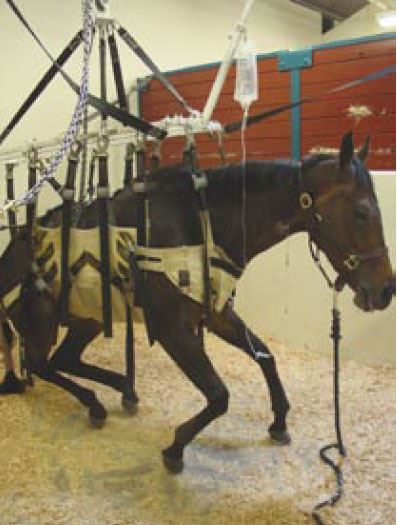By Sarah E. Coleman
While the vast majority of us routinely vaccinate our horses for the “rhino” form of the equine herpes virus 1, many people were unfamiliar with the neurological form of EHV-1 until recently.
EHV-1 commonly causes upper respiratory infections in young horses, presenting as a runny nose, cough and loss of appetite. Most of the horses affected by this type of EHV-1 recover uneventfully. Spread primarily through coughing and sneezing, EHV-1 also has a more devastating neurologic form that has recently been implicated in multiple equine deaths.
Horses that have the neurologic form of the disease can have trouble standing, swelling in the lower legs, and the inability to pass manure or urinate. As many of these signs mimic other disease, it’s important to involve a veterinarian as soon as possible to determine exactly what is affecting the horse.

Because EHV-1 is a virus, it does not respond to antibiotics. Supportive treatment is the only thing that can be done for affected horses, and each treatment is determined individually. Anti-inflammatories and fluids are most commonly administered, and a sling can be utilized for some horses that are unable to stand.
Typically, those horses that do not become recumbent have a good prognosis, though recovery may take multiple months.
Racing Industry Hardest Hit
EHV-1 has been in the news a lot lately, the first cases of 2017 being confirmed at the Louisiana Fair Grounds racetrack. On January 3, one horse tested positive for the neurologic form of EHV-1. That horse was placed in isolation and one barn was placed in quarantine with twice-daily temperature taking of every horse in the barn.
On January 4, three additional barns at Fair Grounds were placed under quarantine and the horse that was originally infected was euthanized. The issue that immediately needed to be addressed was the fact that horses had shipped into and out of the track to train and race—and they may have been exposed to the infected horse. Because of this, the Kentucky Office of State Veterinarian instated a rule that no horse that has resided or been on a Louisiana race track or training center since December 10, 2016, would be allowed entry onto a Kentucky racetrack (for racing or sales).
To gain entry to Kentucky, am owner had to prove that a horse that had been in Louisiana had been removed at least 30 days before the rule went into place; this certification was in addition to meeting standard health requirements.
Even Closer to Home
The same day, a 2-year-old filly was brought to a Lexington equine hospital from Oldham County, Ky. The examining veterinarian alerted the Kentucky Department of Agriculture (KDA) of a possible EHV-1 case after he noticed urine dripping from the horse. A nasal swab and whole blood was taken and the filly was confirmed to have the neurologic form of EHV-1 on January 5.
The KDA then placed the filly’s home farm under quarantine. Additional testing was done on horses that had been exposed to the affected horse in the hospital. Three horses had resulted positive.
On January 9, a second horse on a different farm in Oldham County tested positive for EHV-1, though with a different strain of the virus. The horse was moved to isolation and the facility was placed under quarantine. On January 13, five horses were diagnosed to be positive for EHV-1 via nasal swab. These five horses were moved to isolation areas.
The Oldham County EHV-1 cases had no connection to the Fair Grounds cases. The initial Oldham County horse was released from the equine hospital and sent to isolation. The farm from which she came complied fully with the KDA regulations and ensured that no horse on their property showed any signs of EHV-1.
On January 21, a barn on the backside of Turfway went under quarantine when a horse was diagnosed as positive with the “wild strain” of EHV-1. Two additional horses were diagnosed as positive for the wild strain of EHV-1. Also, samples collected on January 25 from the Keeneland training barns noted that two horses had tested positive for EHV-1.

So Where Are We Now?
As of February 10, the Oldham County premises, Keeneland Rice Road Training Center and Turfway Park were all released from quarantine. Horses that have previously tested positive do remain under regulatory monitoring and remain quarantined in secured, isolated areas.
However, horses that have been at Fair Grounds in Louisiana (or another Louisiana facility where EHV was diagnosed), are not allowed to enter a Kentucky race track or training facility without proper documentation that they are not affected by EHV-1.

Read more at www.kyagr.com/statevet
